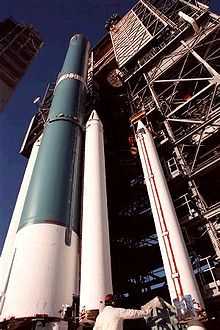Solid rocket booster

Solid rocket boosters (SRB) or Solid Rocket Motors, SRM, are used to provide thrust in spacecraft launches from the launchpad up to burnout of the SRBs. Many launch vehicles include SRBs, including the Ariane 5, Atlas V (optional for extra thrust),[1] and the NASA Space Shuttle. The NASA Space Shuttle used two Space Shuttle SRBs, which were the largest of their type in production service. The propellant for each solid rocket motor on the Space Shuttle weighed approximately 500 000 kg.[2]
Compared to liquid-fuel rockets, the solid-fuel SRBs are advantageous for the purpose of boosting launches because they provide greater thrust and do not have the refrigeration and insulation requirements of liquid-fueled rockets. Adding detachable SRBs to a vehicle also powered by liquid-fueled rockets (known as staging) reduces the amount of liquid fuel needed and lowers the launch vehicle mass.
One example of the increased performance from SRBs is the Ariane 4 rocket. The basic 40 model with no boosters could lift a 2175 kilogram payload to Geostationary transfer orbit.[3] The 44P model with 4 solid boosters has a payload of 3465 kg to the same orbit.[4]
Solid boosters are usually cheaper to design, test, and produce compared to equivalent thrust liquid boosters[citation needed]. However, SRB costs on a per-flight basis tend to be equivalent to those of their liquid counterparts[citation needed].
It is difficult to stop a solid rocket motor before normal burnout. This can be done by explosively separating the nozzle and/or splitting the case lengthwise with a linear shaped charge. The latter method is common in range safety destruct systems. Either method terminates thrust by reducing combustion chamber pressure and propellant burn rate, though the propellant (usually in many pieces at this point) will continue to burn vigorously.
SRB failure rates are about 1%. They usually fail in sudden, catastrophic explosions due to overpressurization, the SRB failure mode on Challenger being an exception.
Solid rocket motors also present a significant handling risk on the ground. Once their propellant is poured into place and cured, they can catch fire or explode. Such an accident on August 22, 2003 killed 21 technicians at the Brazilian VLS rocket launch pad.[5]
The manned and unmanned Shuttle Derived Launch Vehicles currently planned as part of NASA's Vision for Space Exploration both rely heavily on modified versions of the current Space Shuttle solid rocket boosters.
See also
- Liquid Rocket Booster
- Solid-fuel rocket
- Graphite-Epoxy Motor
- Comparison of orbital rocket engines
- Space Shuttle Solid Rocket Booster
References
![]() This article incorporates public domain material from websites or documents of the National Aeronautics and Space Administration.
This article incorporates public domain material from websites or documents of the National Aeronautics and Space Administration.
- ↑ "Data" (PDF), Assets, Lockheed Martin.
- ↑ "Solid rocket boosters". USA: NASA. 2009-08-09..
- ↑ Ariane 4, Astronautix.
- ↑ Ariane 44P, Astronautix.
- ↑ VLS
External links
- HowStuffWorks : Sold Fuel Rocket Engines
- NASA website about the solid rocket booster
- U.S. Centennial of Flight Commission article on solid propelled rockets
- NASA CGI video developed for the Ares program showing recovery of solid rocket booster